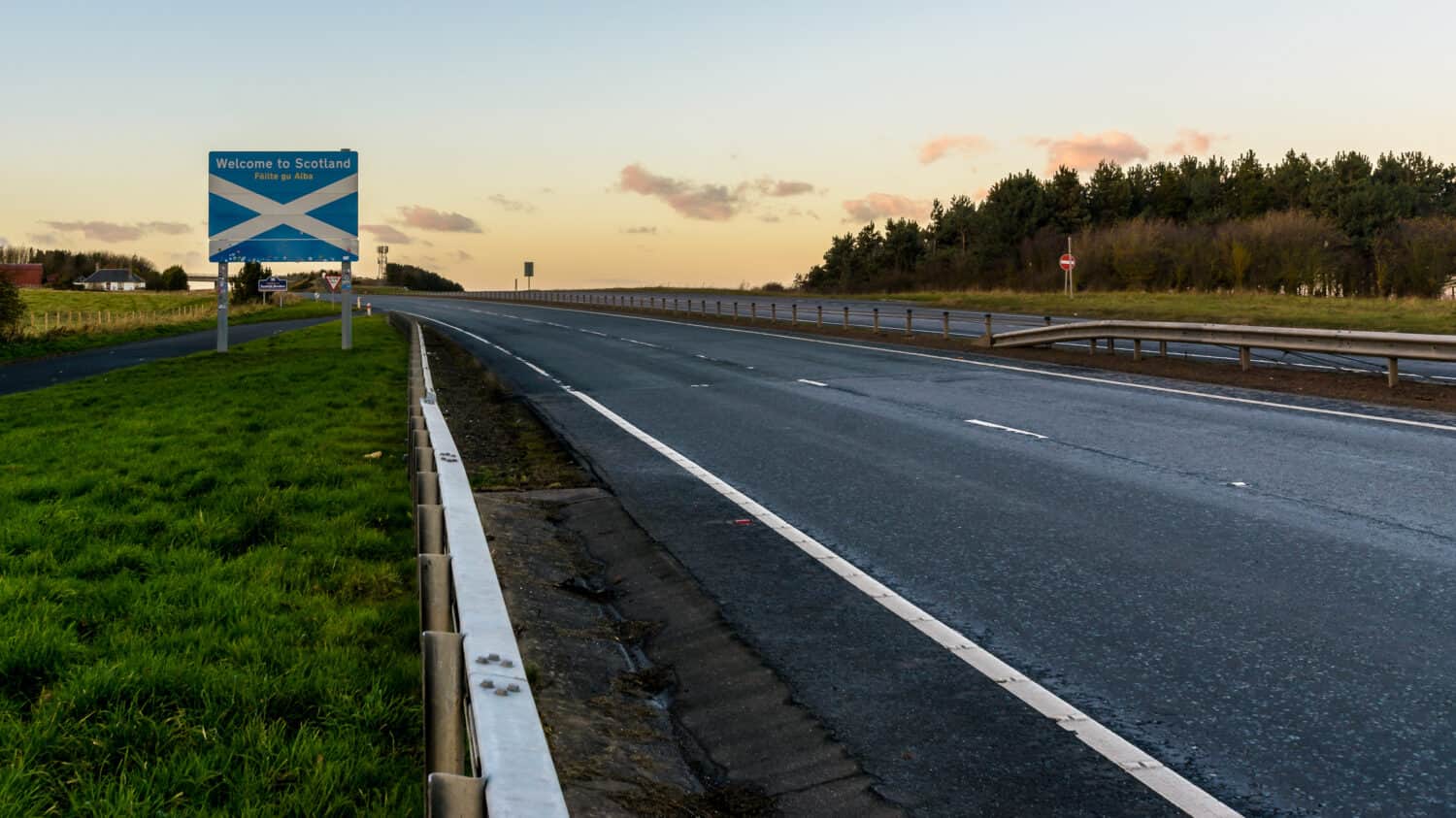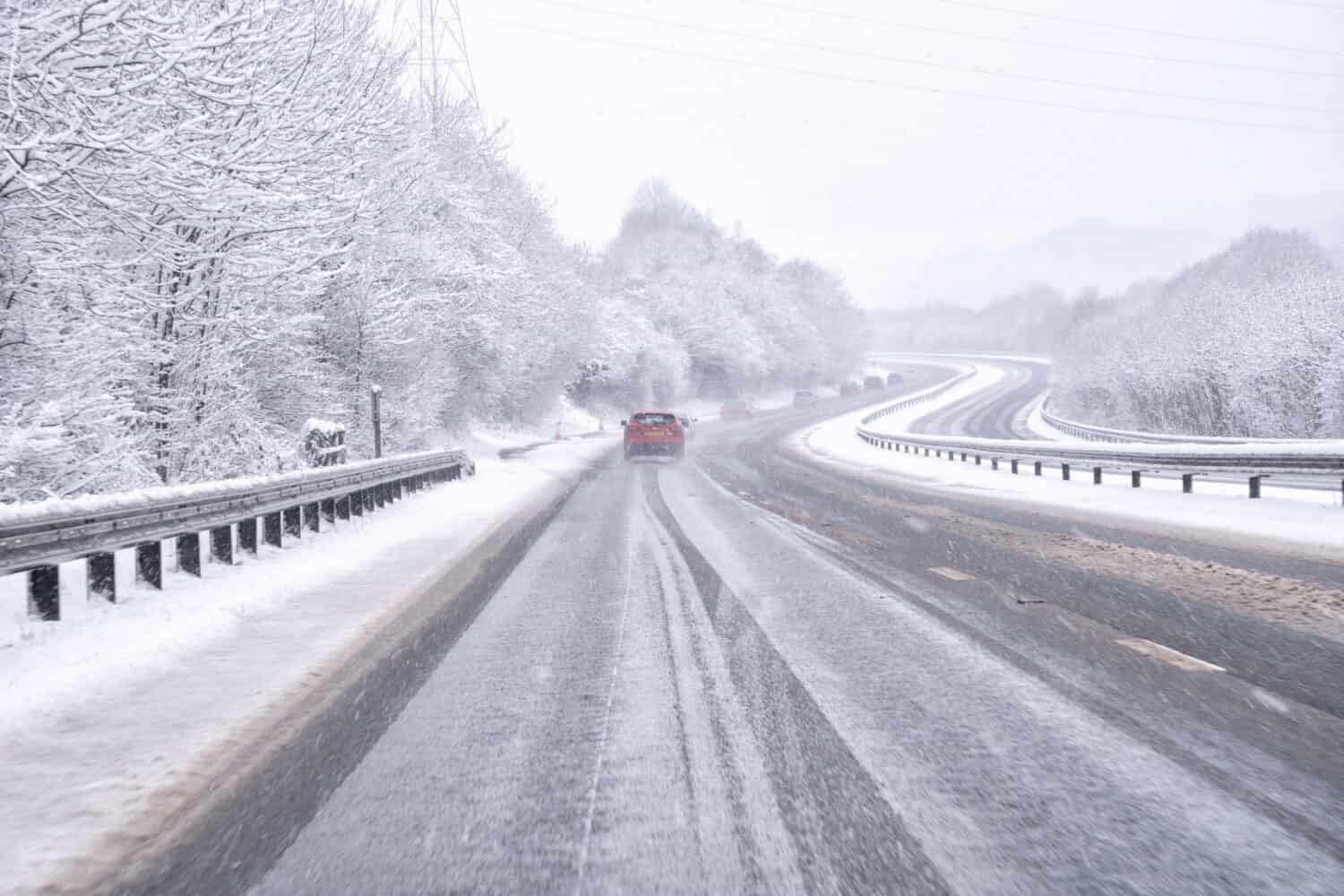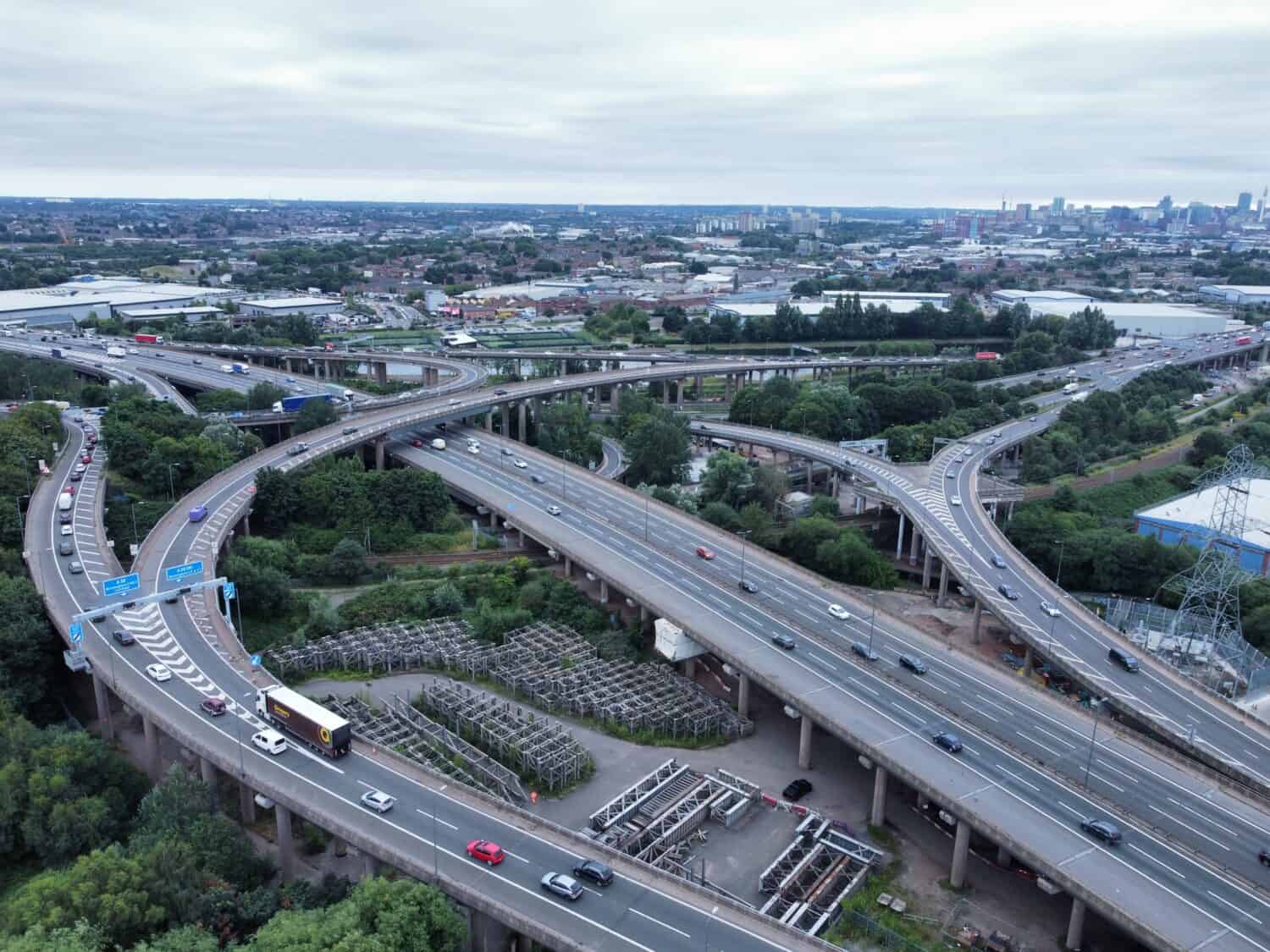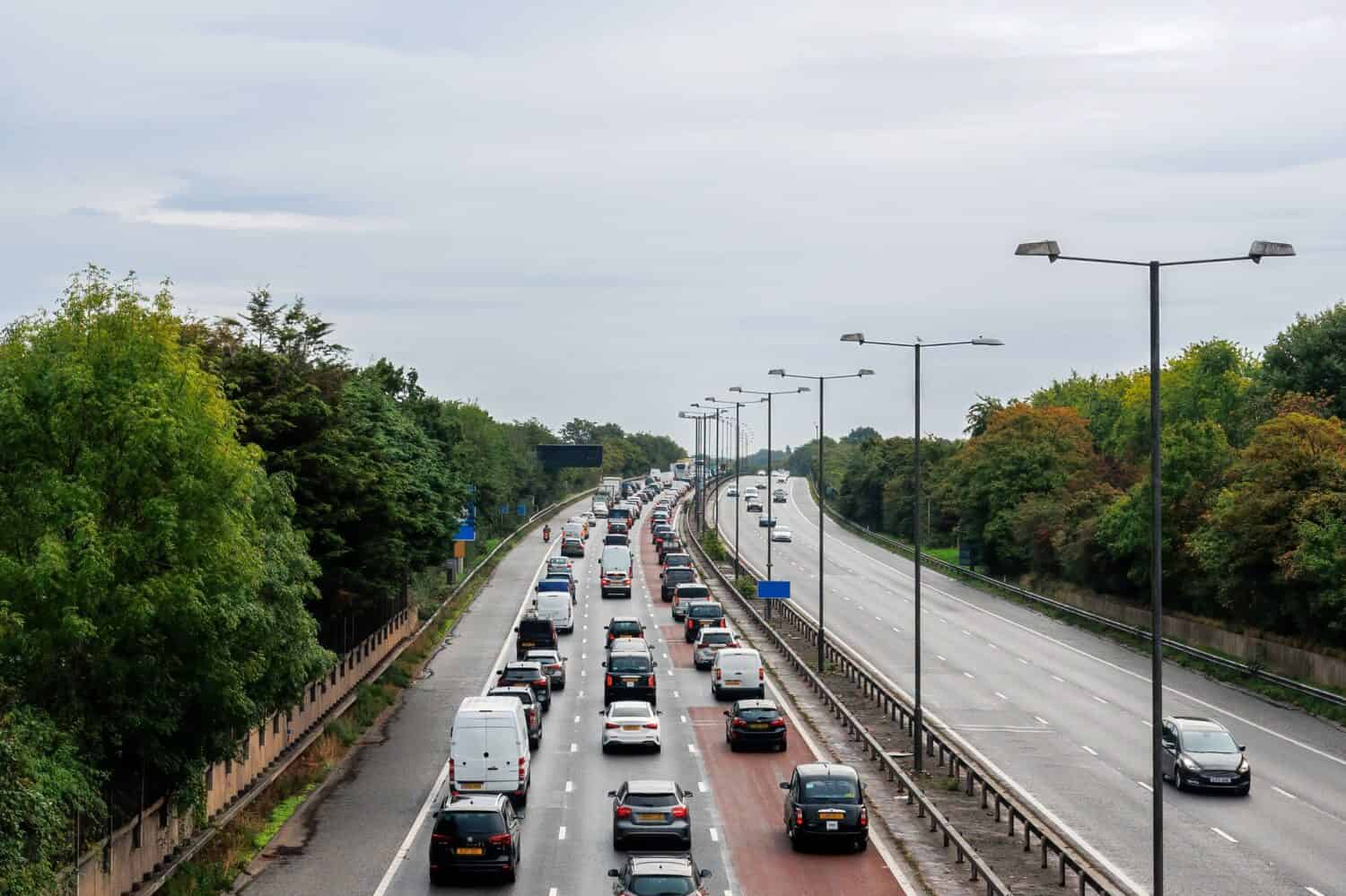Currently, the UK’s paved road network is 247,100 miles long. That’s 2,300 miles of motorway, 29,000 miles of A road, and the rest comprised of smaller B, C, and U (unclassified) roads. It’s a road system built over thousands of years, but which road stretches the furthest? This article uncovers some of the longest roads in England and interesting facts about England’s road network.

1. A1: 396 miles (637 km)
The A1 runs from London to Scotland’s capital Edinburgh. Some folk think the A1 doesn’t count as England’s longest road because it’s not wholly within England, but even if we stop at neighboring Scotland’s border, it’s still the longest at 396 miles.
Many of England’s longest roads are “A” road classified, not motorways which are larger and faster roads. The A1 is probably the most important route in the country. It covers 410 miles from London’s center, through the Midlands, Yorkshire, Northumbria, and finishes in Edinburgh’s center.
Since the 1920s, this road has been classified as an A route, but it’s carried traffic since before the Roman invasion in 43AD. The Anglo-Saxons and Normans built more roads until they eventually reached Scotland. Today, it’s lined with famous coaching inns which once served horse-drawn carriages but now serve modern cars and trucks.

England’s longest road stretches from London to the Scottish border.
©Jacek Wojnarowski/Shutterstock.com
2. A38: 309.8 miles (498.6 km)
In second place (if you’re counting the A1) is another A road, the A38, which runs 309.8 miles from Bodmin on Cornwall’s coast to Mansfield in Nottinghamshire. It’s the longest road wholly within England’s border and one of the most important south-to-north roads there.
Built by Romans in the 1st century AD, the A38 still carries vast amounts of traffic, especially in summertime when Cornwall’s tourist season gets underway. It’s nicknamed “The Holiday Road” or “The Devon Expressway,” and many folk choose it over the parallel M5 due to its breathtaking scenery.

The A28 runs from Cornwall to Mansfield in Nottinghamshire.
©Rob Fuller/Shutterstock.com
3. A30: 284 miles (457 km)
The A30 from Lands End in Cornwall to Hounslow, London, stretches 284 miles. It’s the third longest A road in England. This road is one of great nostalgia because it was the mainfolk to reach the coast for hundreds of years route for towns. In the 18th and 19th centuries, innumerable coaches traveled its length, transporting wealthy Londoners to the fresh air.
This main route to the coast cuts Cornwall County in two. It was used to move tin and copper from Redruth and Camborne and china clay from Bodmin and St Austell’s mines through Devon and onto the British Empire trade routes. During improvements works, ancient artifacts such as 6,000-year-old Mesolithic flint scatters are regularly uncovered.

The A30 runs from Lands End in Cornwall to London.
©Paul Nash/Shutterstock.com
4. A6: 282 miles (453.8 km)
The 282 miles A6 connects Luton in Bedfordshire with Carlisle in Cumbria, home of the beautiful Lake District. It runs north to south through Manchester city center and historic Lancaster.
In 1816, existing road improvements, boosted by increasing trade and holiday tourism, created the beginnings of the A6. Some routes, such as the local Derby road, were widened by blasting extra space from the limestone cliffs. These works made the A6 one of the main roads stretching north to south, and it remains so today.
When it was first classified in 1921, the A6 was England’s longest road (not counting the A1 for reasons we’ve discussed). The A7 immediately picks up where the A6 finishes in Cumbria to finish the journey to Scotland.

The A6 is one of England’s main north to south routes.
©Altaf Shah/Shutterstock.com
5. M6: 236 miles (379.8 km)
The first motorway to hit our list of England’s longest roads is the 236-mile M6 taking us from Catthorpe, Leicestershire to Gretna Green in Dumfriesshire. The M6 stops just short of the Scottish border, so it’s wholly contained in England.
The longest motorway in England takes motorists from the Midlands into Liverpool, Manchester, and into the center of Lancashire before a straight run to Gretna Green via the stunning Lake District’s mountains and lakes.
The M6 was Britain’s first motorway. Designed by Sir James Drake, it was first called the Preston Bypass and opened in 1958.
The busiest section sits between Junctions 4 and 10 in the West Midlands and Cheshire’s Junctions 16 to 18. These sections caused so much traffic congestion they’re now upgraded to smart motorways. If you’ve not heard of them, the UK’s smart motorways use traffic management systems to increase capacity. They employ techniques such as using the hard shoulder as a running lane and varying traffic speeds to control traffic flows.
The M6 is also home to the Gravelly Hill Interchange, colloquially known as “Spaghetti Junction,” a complicated appearing structure that’s Britain’s first free-flowing interchange (without traffic lights or roundabouts.)

Spaghetti Junction is on J6 of the M6 motorway.
©Adrian Newton/Shutterstock.com
6. A41: 222 miles (357.2 km)
The A41 trunk road runs 222 miles between London and Birkenhead. It passes through Watford, Birmingham, Wolverhampton, and Newport, in part following an old Roman road line. Archaeological digs suggest the road is an even old older track, reworked by the Romans to enhance trade routes between the countries of Gloucestershire and Hertfordshire.
In 1990 the new M40 from Junction 8 took most of the traffic, so parts of the A41 were downgraded to B roads. However, this route is still one of the longest primary routes in England.

The A41 road is replaced in parts by the M40 motorway.
©Peter_Fleming/Shutterstock.com
7. M1: 200 miles (321.9 km)
Despite having a “top-of-the-pile” name, the M1 is not the longest road in England! It’s only the second longest motorway in England, stretching 200 miles from Staples Corner in London to Hook Moor in Yorkshire.
However, even though it’s not as long as the M6, it’s arguably more important. It’s the primary north-to-south route used by millions of motorists every year.
Built in 1959, WW2 delayed this route by over a decade. Preston Bypass in Lancashire was the first section opened (but that’s now part of the M6, as we’ve already seen above). At the time, the M1 had no speed limit or crash barriers, which sounds highly dangerous, but few people owned cars back then. Those that did could picnic beside the motorway as it had so little traffic.

The M1 is England’s second longest motorway.
©LD Media UK/Shutterstock.com
8. M4: 192 miles (308.9 km)
The M4 that cuts across the Thames Valley is 192 miles long. Approximately 120 miles lie in England and 70 miles in Wales. It’s the main east-to-west route across England with the nickname “the M4 corridor,” although it was known as the London-South Wales motorway.
This busy road starts in Chiswick, London, and finishes up on Pembrokeshire’s border, but it’s one of England’s worst for congestion. Motorists are advised to check congestion before using this heavily trafficked road.
It’s actually one of two UK roads to feature three four-level interchanges. These sit on Junction 4B and 20.

East to west M4 is one of the most congested roads in England.
©MagicBones/Shutterstock.com
What’s An “A” Road in England?
You might be wondering why some of England’s longest roads are classed as A roads and not motorways. Well, some of England’s busiest roads are the oldest routes, walked, ridden, and finally driven for thousands of years, but the classification system was devised in the 1920s before motorways were built.
“A” roads have single carriageways, and traffic passes in both directions. They’re designed to take heavy traffic footfall and provide large-scale links between areas. Motorways are larger. They have several lanes of traffic traveling in the same direction. The speed limit for England’s motorways is 70 mph, but it’s 60 mph on A roads.
In the busiest areas, new motorways offer faster alternative routes to the same destinations, so many run along A roads.
England’s Most Dangerous Road
All roads can be considered dangerous because a lot depends on weather and the driver’s capability, but one of England’s most dangerous roads is the 10-mile-long A357 Cat and Fiddle Road (named after a local inn).
Its twists, turns, and hairpin bends run through Derby, Buxton, and Cheshire. Officials say that many motorists drive too fast and lose control here despite its numerous safety measures. Between 2002 and 2013, 113 crashes occurred.

Cat and Fiddle Road is one of England’s most dangerous roads.
©Anthony Dillon/Shutterstock.com
Keen to find out more? Here are five interesting facts about roads in England:
5 Interesting England Road Facts
- The M61 in Greater Manchester has 17 lanes and eight hard shoulders. It’s a tricky one to navigate!
- The M62 is England’s highest motorway. It’s 1,222 feet above sea level.
- The shortest UK motorway is central Manchester’s A635(M). It’s only 1,968 feet long.
- The M25 circles London to create the UK’s longest ring road. It covers 118 miles.
- Swindon’s “magic roundabout” is considered the most difficult to navigate. It’s a central roundabout with five mini satellites that interconnect. Despite its difficulty, few accidents occur due to the snail-like traffic speeds of confused drivers.
- England’s steepest road is 33% incline Hardknott Pass in Cumbria
Summary of the 8 Longest Roads in England
| Number | Road | Road Length |
|---|---|---|
| 1 | A1 | 396 miles |
| 2 | A38 | 309.8 miles |
| 3 | A30 | 284 miles |
| 4 | A6 | 282 miles |
| 5 | M1 | 200 miles |
| 6 | A41 | 222 miles |
| 7 | M1 | 200 miles |
| 8 | M4 | 192 miles |
Thank you for reading! Have some feedback for us? Contact the AZ Animals editorial team.







